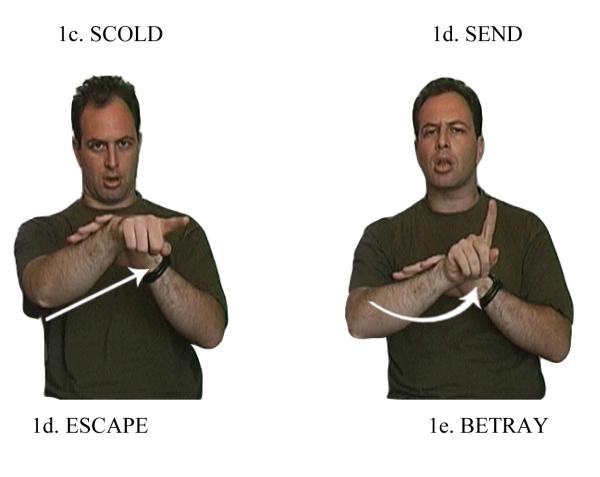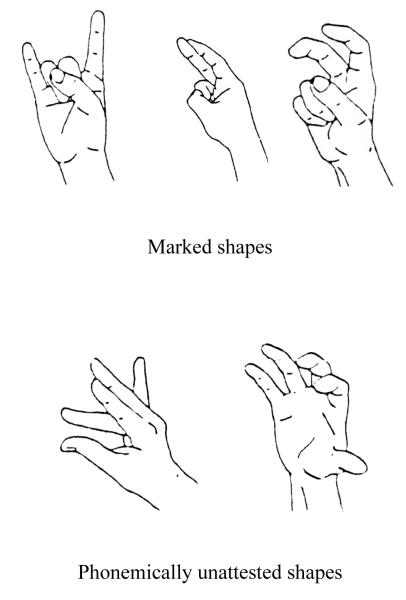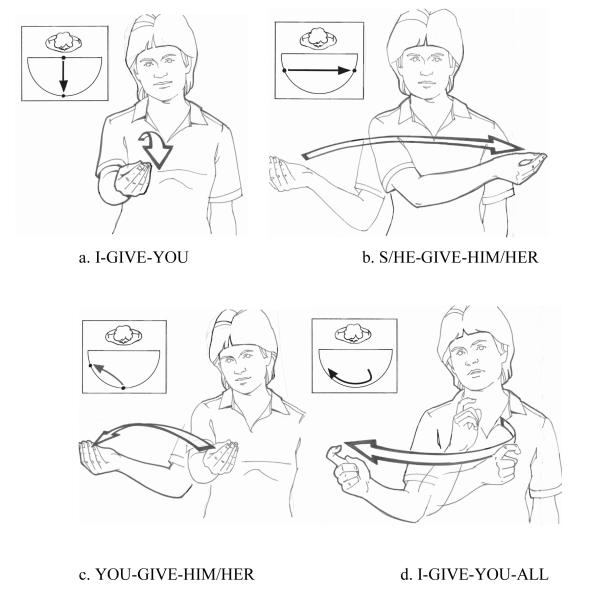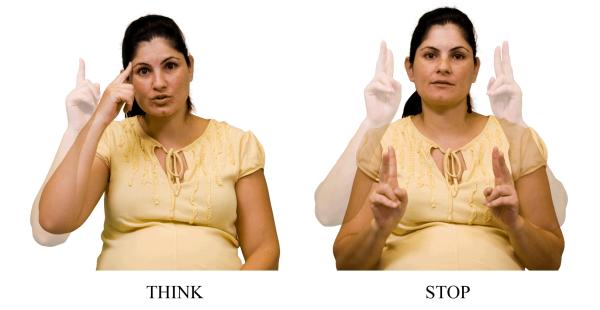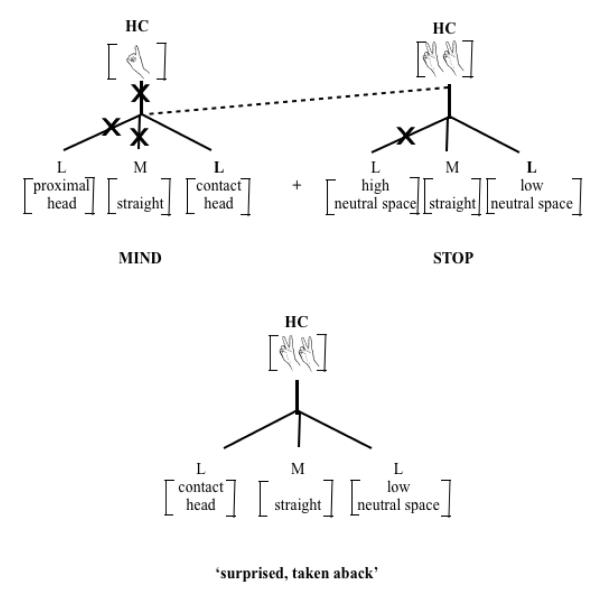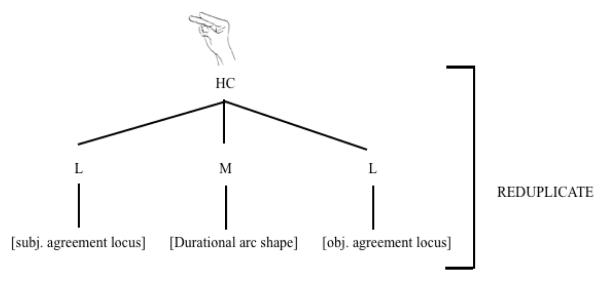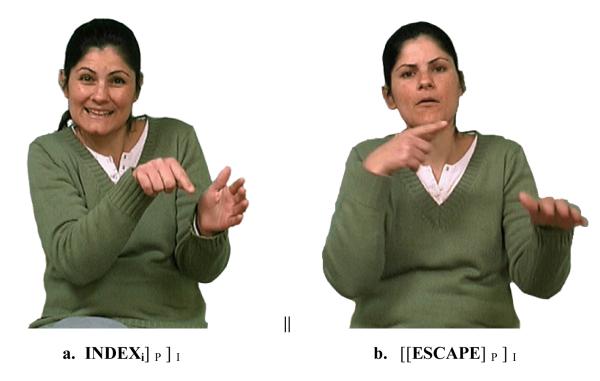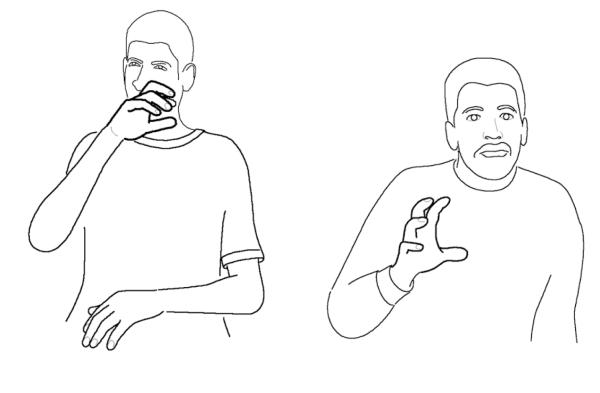Abstract
Visually perceivable and movable parts of the body – the hands, facial features, head, and upper body – are the articulators of sign language. It is through these articulators that that words are formed, constrained, and contrasted with one another, and that prosody is conveyed. This article provides an overview of the way in which phonology is organized in the alternative modality of sign language.
1. Introduction
The sign language signal is shaped by the hands, face and body. The speech signal is shaped by articulators inside a tube extending between the lips and the vocal cords. Despite this glaring difference, sign languages have phonology. Stokoe’s (1960) demonstration that American Sign Language signs are created from a finite list of meaningless elements that combine and recombine provided the clearest proof that signs, like spoken words, are characterized by duality of patterning (Hockett 1960), and that signs are not holistic pictorial gestures, as previously believed. Essentially, phonology is where the body meets grammar.
The goal of this overview is to demonstrate how phonology is organized in a physical system with many disparate articulators. Section 2 presents some minimal pairs in sign language, and describes the major categories of phonological organization: Hand Configuration, Location, and Movement. Each of these categories is further refined by subcategories, and some of the hierarchical organization of major sign language categories is introduced in that section. While each formational element makes its contribution to phonological structure, the elements are not free to combine with one another haphazardly. Instead, constraints on their combination act to mold them into a system. Six common constraints on phonological form in sign languages are presented in table form in Section 3.
A sign gives the impression of an amalgamation of articulations occurring all at once, and indeed there is more simultaneous structure in signs than in spoken words. Yet the morphophonology must sometimes isolate the beginning, the middle, and the end. In Section 4, the overall organization of the sign is considered, focusing on both sequential or segmental (linear) and simultaneous (nonlinear) aspects of structure.
The physical articulators of a language do more than shape its words. They also provide temporal structure that divides and connects parts of utterances, flavoring them with intonations that convey part of their meaning. The prosodic system of sign language and the intonation of the face are summarized in Section 5.
The phonology of the nondominant hand – a dual articulator with no spoken language equivalent, acting simultaneously with the dominant hand – is outlined in Section 6. It is shown there that the linguistic system of sign languages makes the most of this ‘extra’ articulator afforded by the modality: the nondominant hand may manifest a meaningless phonological unit, a morpheme, or even a sign, and, as such, may cooccur in the signal with different linguistic domains encoded by the dominant hand.
Apparently, apart from certain interesting differences that have already surfaced, phonologies of different sign languages have enough in common to make it possible to talk about sign language phonology generally, even though there are hundreds of sign languages in the world. The reason suggested here is that all sign languages are young, and, as such, exhibit the early stages of phonologization grounded in the phonetics of the modality.
Cross sign language similarities notwithstanding, this phonological structuring is not automatic; it does not arise immediately. In Section 7, some current research on the emergence of phonology in a new sign language will be introduced to show that phonological organization is not instantaneously present at the dawn of linguistic communication, but rather develops gradually. Theoretical implications for our understanding of phonology in human language generally are considered in the Conclusion, Section 8.
A single model for representations is adopted here for coherence: the Hand Tier model (Sandler 1989). For in-depth recent overviews of sign language phonology, see Sandler and Lillo-Martin (2006, Unit 3); Brentari (2011a,b).
2. Parameters of Contrast
The words of a sign language lexicon are comprised of a finite number of discrete, meaningless, contrastive units (Stokoe 1960). Meaningful morphemes and words are made up of such units, which can be recombined or substituted for one another to create new words. This kind of structuring makes it possible to amass a vast vocabulary, and no other species has it (Hockett 1960). Following Stokoe’s work on American Sign Language (ASL), and taking examples from Israeli Sign Language (ISL), we see in Figure 1 that minimal pairs can be created by substituting units in the categories of (a) handshape, (b) location, or (c) movement.
Figure 1.
Minimal pairs in Israeli Sign Language distinguished by handshape (DANGEROUS and INTERESTING, distinguished by different selected finger groups), location (SCOLD signed near the head and SEND signed near the torso), and movement (ESCAPE with straight movement and BETRAY with arc movement).
For Stokoe, members of each of these major categories is seen as equivalent to a phoneme, but, as in spoken language, later research showed that features of each category have internal organization. The following subsections describe the phonological categories of lexical signs.
2.1. Hand Configuration
In a monomorphemic sign, the handshape consists of one or more selected fingers in a particular position-- extended, closed, curved, or bent. Figure 2 exemplifies these positions for shapes that select all fingers (ignoring the thumb, for simplicity).
Figure 2.
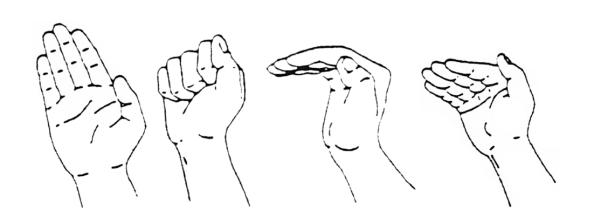
All fingers selected in extended, closed, curved, and bent positions.
If there is a handshape change in a sign, all selected fingers change position in the same way (Mandel 1981). These facts motivate part of a hierarchical model called the Hand Tier (HT) model (Sandler 1986, 1989). The model is developed in the spirit of Clements for spoken language (1985), and represents finger position as subordinate to selected fingers (Sandler 1989; van der Hulst 1993; Brentari 1998), as illustrated schematically in Figure 4 below. Recent research shows that there are handshapes in some far eastern sign languages in which selected fingers may be in different positions (Eccarius 2002; Tang 2007; Fischer and Gong 2010, 2011), often as a result of borrowing of shapes from the fingerspelled characters of the spoken language alphabet or from other graphic symbols.
Figure 4.
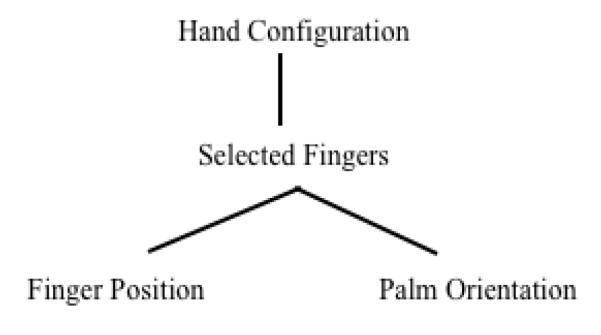
Hierarchical relations among Hand Configuration feature classes (adapted from Sandler 1989)
Even in sign languages without these unusual shapes, like ASL, some handshapes are often referred to in the sign language literature as more “marked”. First, less marked shapes are easier to produce (Battison 1978). While not all easy-to-produce signs are frequent in the lexicon of a sign language (Ann 2005), the most frequent shapes are easy to produce (Battison 1978). Members of the unmarked set (in ASL at least) are acquired earlier by children (Boyes Braem 1981), last to break down in aphasia (Whittemore 1987), and less restricted in their distribution (Battison 1978).
Influenced by the theory of Dependency Phonology (Ewen 1995), relative markedness has been associated with relative complexity in the representation (van der Hulst 1993; Sandler 1996; van der Kooij 2002; Brentari and Eccarius 2010). As examples, Figure 3 shows three unmarked shapes, three marked shapes, and two shapes that are not attested in native sign language lexicons (they violate constraints 1 and 3 in Table 1, below).
Figure 3.
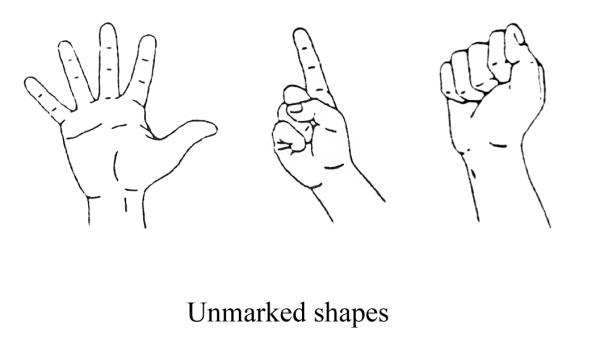
Unmarked handshapes, with index or adjacent fingers selected and extended or closed in shape; marked handshapes with nonadjacent fingers selected or with curved or crossed shape; and shapes that are unattested in phoneme inventories.
Table 1.
Common constraints on sign form found across sign languages.
| CONSTRAINTS ON THE FREE MORPHEME |
|
| 1. Selected finger constraint (Mandel 1981) |
There may be only one (group of) selected finger/s in a free morpheme |
| 2. Internal movement constraint (Mandel 1981) |
If there is a change of finger position in a morpheme, all selected fingers make the same change. |
| 3. Unselected fingers constraint (Corina 1993) |
If selected fingers in a free morpheme are closed, unselected fingers are open. If selected fingers are in any other position, unselected fingers are closed. |
| 4. Symmetry constraint on two-handed signs (Battision (1978) |
When both hands move in a free morpheme, they must be symmetrical in handshape, movement, and location |
| 5. Dominance constraint on two-handed signs (Battison 1978) |
When one hand is active and the other is passive (i.e., functions as a place of articulation) in a free morpheme, the passive hand either has an unmarked shape or it has the same handshape as the active hand |
| CONSTRAINT ON THE SYLLABLE |
|
| 6. Movement in syllables (Brentari 1998) |
A syllable must contain a movement, either a path movement, a handshape change, or an orientation change. These different types of movement may combine simultaneously, but maximally one of each type may occur in a single syllable. |
Different sign languages have different handshape inventories. To account for such differences, Eccarius (2008, 2011) introduces different rankings of (violable) Faithfulness and Markedness constraints, following principles of Flemming’s (2002) Dispersion Theory (within Optimality Theory (Prince and Smolensky 1993; McCarthy 2007). See Brentari (2011a) for a current overview of the category of handshape.
Orientation features, which determine the orientation of the palm, can be contrastive, and indeed [supine] and [prone] are listed as features of handshape in the notation system devised by Stokoe (1960). Some researchers incorporate orientation as a fourth major category. Based on the physiological relation between the palm and the whole hand, as well as on assimilation behavior observed in lexical compounds in various sign languages, other models represent orientation as a subordinate category to the major category of hand configuration (Sandler 1987, 1989 for ISL; van der Hulst 1996 for SLN; Sandler & Lillo-Martin 2006 for ASL and ISL; van der Kooij 2002 for SLN). Further research is required to determine whether this hierarchical relationship holds throughout the phonology and across sign languages.
2.2. Location
Just as the category of handshape consists of dominant and subordinate categories, so too does the category of location. Each free morpheme is restricted to a single major body area – such as the head, torso, nondominant hand, or nondominant arm (Battison 1978). But in signs with typical path movement, two settings -- specific areas with respect to some location – may be specified. In the sign for DEAF in many European based sign languages (including ASL), for example, the hand contacts first a setting near the ear ([high]) and then a setting near the mouth ([low]), both on the same location, the head. In hierarchical models in which lower categories are refinements of higher categories, the sign language facts assign to the setting category a subordinate position relative to location (Sandler 1989; van der Hulst 1993; Brentari 1998; van der Kooij 2002). For signs that do not involve actual contact with two different settings, such as those in Figure 1, researchers are divided about whether they involve two settings at a major location (e.g., [proximal] and [distal]), or only a major location with a movement feature such as [toward], [away], etc. The choice is determined in part by whether additional motivation is recognized for isolating the initial and final setting independently, an issue explored further in the following section and in Section 4.
2.3. Movement
Lexical signs may be characterized by a path movement from one location to another, as are all signs in Figure 1. Alternatively, only the fingers may move, by changing from closed to open, for example. In addition, the whole hand can move by changing its orientation, creating movements such as rotation or nodding. These non-path movements are called hand-internal movements or local movements. Two (or, more rarely, all three) of these movement types may also co-occur simultaneously in a sign. The signs SCOLD (Figure 1c) and SEND (Figure 1d), for example, involve both forward path movement and opening hand-internal movement.
Features of path movement can distinguish some minimal pairs, like the [arc] shape that distinguishes BETRAY (Figure 1f) from ESCAPE (Figure 1e), or the feature [tense] or [doubled]. However, path movement is often a default straight path movement from one location to another, as in all signs in Figure 1 except for BETRAY. Signs may also be characterized by alternating movement of the two hands, or by iterated patterns that can be described as unidirectional (repeated) or bidirectional (returned) (e.g., Supalla and Newport 1978; Newkirk 1981:1998; Mak and Tang 2011).
We know that movement is part of the phonology, not only from minimal pairs, which are rather scant, but also because the specification for movement is active in the grammar, morphologically and phonologically. For example, in the verb agreement system, described in Section 4 below, plural object agreement is marked by inserting a movement in the shape of an arc on the horizontal plane in the movement segment (Figure 6d). But signs that are already specified for any movement feature except the default straight movement, such as [arc] in BETRAY, cannot get this plural object marking in ASL (Padden 1988) or in ISL Sandler 1996); it is blocked phonologically.
Figure 6.
Examples of verb agreement in ASL. Illustrations reprinted with permission from Carol Padden.
In addition to plural object agreement, movement shapes and patterns are exploited in temporal aspect systems (Klima & Bellugi 1979; Newkirk 1981:1998; Sandler 1990). Temporal aspect inflections can alter the shape and timing of the movement of a sign, as seen in Figure 9 from ASL in Section 4.2 below. Different movement types also figure prominently in dynamic constructions denoting motion and location (Supalla 1986).
Figure 9.
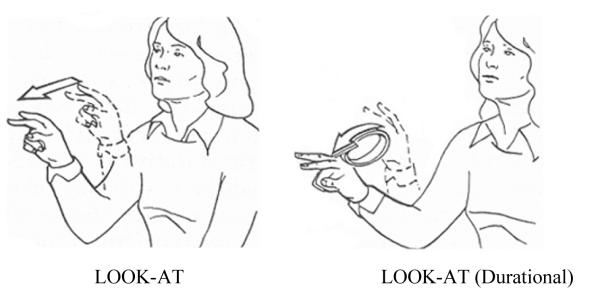
The uninflected ASL sign LOOK-AT and LOOK-AT inflected for Durational aspect. Reprinted with permission from Ursula Bellugi.
Because of its salience and other properties, movement is considered by most researchers to be the nucleus of the sign language syllable. The ubiquity of movement is one motivation for the Prosodic Model of sign language phonology (Brentari 1998), which separates all features on the basis of whether they are static (inherent) or whether they either manifest or give rise to movement (prosodic). The category of movement is reviewed in Sandler (2011a).
3. Constraints
Duality of patterning, defined in Section 1, is a necessary condition for a phonological level of structure, but not sufficient in itself. In all known languages, there must also be constraints on the ways in which the discrete, meaningless units may combine with one another. Table 1 describes in simplified form some of the constraints on sign formation that have been found across the few sign languages whose phonological structure has been studied in depth. While the domain of several of these constraints was originally posited to be the ‘sign’, they are better understood as constraints either on the free morpheme (synonymous with the core lexeme, Brentari and Padden, 2001) or on the syllable, and presented as such here.
These constraints are not violable and apply to any free morpheme, so that their effects are cumulative. For example, the selected finger, internal movement, and syllable structure constraints taken together mean that a single group of selected fingers can change its position uniformly and only once within a syllable. This is what we see in Figures 1c and 1d. However, morphemes, syllables, and signs can be distinguished from one another; they are not isomorphic (Brentari 1990; Sandler and Lillo-Martin 2006).
The constraints shown in Table 1 are robust and reflect sign structure in many sign languages, but the list is not exhaustive. Many additional phonological constraints, some of them interacting, have been proposed in the context of particular models of sign language structure (see Perlmutter 1992; Brentari 1998; Sandler 1999; Eccarius 2011).
4. Sequentiality and simultaneity
There is typically only one handshape across a sign, one major location, and one movement. This gives the impression of simultaneity in the phonological organization of the sign, and indeed Stokoe proposed that signs are simultaneous in structure, unlike spoken words, in which segments are sequentially organized. While most current models acknowledge sequential structure in signs, some models propose that it is not underlying (van der Hulst 1993; Wilbur 1993; Brentari 1998; Channon 2002), and models differ in whether sequentiality is expressed at the level of segments, class nodes, or features.
4.1. Why sequentiality?
Beginning with Liddell (1984), researchers found that some phonological and morphological processes are best accounted for by attributing a certain amount of sequential structure to the sign (Newkirk 1981:1998; Liddell 1984; Sandler 1986, 1989; Liddell and Johnson 1989; Perlmutter 1992). In these models, two static locations are connected by a movement, giving the canonical sign the structure of Location-Movement-Location, LML (Sandler 1986, 1989; or Hold-Movement-Hold in Liddell 1984, Liddell & Johnson 1989; or Position-Movement-Position in Perlmutter 1992). In rare examples, morphologically simplex signs are minimally distinguished by a single linear segment, as in ASL CHRISTIAN (Figure 5a) and COMMITTEE (5b), which share the same first setting (high on the contralateral side of the torso), but are distinguished by the last setting: low and ipsilateral for CHRISTIAN, and high and ipsilateral for COMMITTEE.
Figure 5.
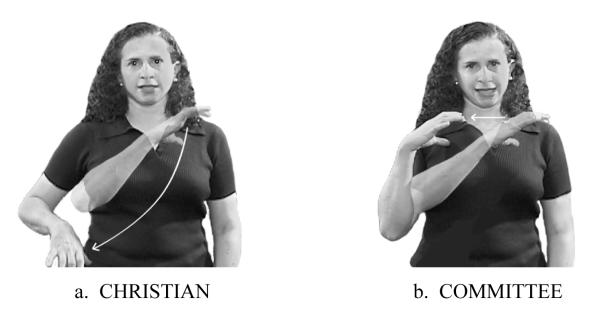
ASL signs distinguished only by the second sequential setting.
In these signs, that last L of the LML structure distinguishes the two. Since the movement carries visual salience or ‘sonority’, it may be useful to compare LML to CVC of spoken language, as researchers have done, though how literally the analogy is intended to be taken varies from one researcher and model to another.
Morphological complexity more clearly reveals linear structure in signs, even in cases in which the morphological operation itself gives the impression of simultaneity. A prominent example is found in verb agreement systems common to many sign languages (Padden 1988; Meir 2002; Aronoff et al 2005). In these systems, referential loci (R-loci, Lillo-Martin and Klima 1990) are set up in the signing space to represent subject and object referents, and signs belonging to the class of agreeing verbs move from the R-locus of the subject to that of the object. Figure 6 illustrates part of the system.
The point for phonology is that the first and last location of the sign must be independently identified by the grammar, providing good evidence for the existence of each in the phonological structure of the sign. The system illustrated here is common, but sign languages with verb agreement may differ in the phonological realization of agreement and its conditioning, as shown in Mathur and Rathmann (2010).
More evidence for sequential structure comes from the particular way in which lexical compounds tend to reduce, often deleting the first location of the first and secondsign (Liddell and Johnson 1986; Sandler 1989, 1993). In Figure 7, the ISL lexical compound THINK^STOP= ‘surprised, taken aback’ is illustrated. Reduction of this compound is represented schematically in Figure 8, in which the first setting of THINK is deleted, as is the first setting of STOP, leaving the second setting of each sign to survive in the compound, and resulting in a canonical, monosyllabic, LML form.
Figure 7.
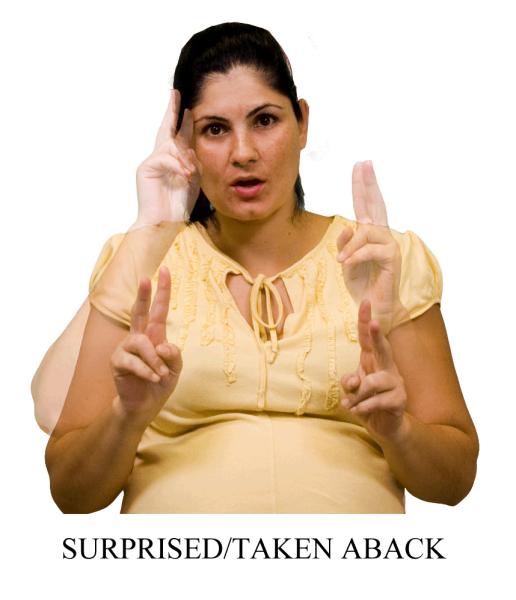
Reduced ISL compound: THINK^STOP, ‘surprised, taken aback’.
Figure 8.
Schematic representation of compound reduction: Deletion of locations and assimilation of hand configuration in THINK^STOP, ‘surprised, taken aback’ (adapted from Sandler 1987, 1989). Doubled handshapes on STOP and on the compound sign indicate that the sign is two-handed and symmetrical.
In addition to considerations of sequentiality, the sort of discrete Hand Configuration assimilation shown in Figures 7 and 8 provides additional evidence for a phonological level of structure in general, as the process manipulates abstract formational elements in a systematic way regardless of meaning. Few phonological processes of this kind have been reported in the literature, a point to which we return in the Conclusion. However, coarticulation and other phonetic phenomena have been identified and studied in sign languages (Crasborn 2001, in press, Mauk, Lindblom, and Meier TISLR, Cheek 2001).
Figure 8 makes schematic use of the basic structure of the Hand Tier model (Sandler 1989; Sandler & Lillo-Martin 2006). Through it we see both the structural and temporal relationships among the different categories, and the nonlinear behavior of the hand configuration, represented on its own autosegmental tier in this model. This and other current models of sign language phonology are motivated by theoretical considerations that follow the work of Goldsmith (1976), McCarthy (1981), and Clements (1985) for spoken language. More evidence for segmentation is found in the distribution of a morpheme for the Delayed Completive aspect in ASL – a tongue wag or finger wiggle which characterizes only the first segment of a sign (Brentari 1998).
4.2. Simultaneity
The temporal aspect system lends itself to an analysis that singles out the movement and specifies it for a particular shape or for gemination (Sandler 1990, 1993b). But these very same forms also contribute to the impression of simultaneity in sign structure. Figure 9 illlustrates the sign LOOK-AT uninflected, and inflected for agreement and Durational aspect. The inflected form is represented schematically in Figure 10. The form isolates sequential elements, but still conforms to the basic LML structure. No sequential morpheme is added to inflect the sign, and this simultaneous layering is typical of sign language morphology (Wilbur, Bellugi, and Klima, 1983; Aronoff et al 2005). There are four morphemes in this sign: The Hand Configuration is that of the verb root, LOOK-AT; each location encodes a different referential locus; and the movement encodes Durational aspect. The organization is at once sequential and simultaneous.
Figure 10.
Sequentiality and simultaneity of structure in a sign with four morphemes, meaning, ‘She/he looked at him/her for a while’.
While the generalizations described here are well captured by this model, other generalizations are not, such as the predictability of the linear structure and the frequently default nature of the movement segment, and these provide motivation for alternative models of sign language structure (e.g., van der Hulst 1993; Brentari 1998). In sum, signs have more sequentiality than is readily apparent, while properties of visual perception and manual production seem to conspire toward more simultaneous than sequential complexity in signs (Brentari 2002, 2011b; and Meier 2002; Sandler and Lillo Martin 2006, Chapters 9 and 25).
5. Syllables and phrasal prosody
In sign languages that have been studied, all signs have some kind of movement (Wilbur 1993), even if it is often a default straight path movement. This implies that there is some function for movement, and it has been argued to constitute the visual equivalent of sonority (e.g., Liddell 1984; Brentari 1990, 1998; Liddell & Johnson 1989; Sandler 1989, 1993, 2008; Corina 1990; Perlmutter 1992). A single movement, or a simultaneous combination of movements, constitutes a sign language syllable (Brentari 1998). Some reduplicative morphological processes make reference to the syllable (Sandler 1989, Sandler and Lillo-Martin 2006), motivating its existence in the phonology. Most signs have only one syllable (Coulter 1982), even if they are morphologically complex, as seen in Figures 6-10 above (Sandler 1999). For overviews of the syllable in sign languages, see Sandler and Lillo-Martin (2006); Wilbur (2011); and references cited there.
The prosodic structure of sign languages does not stop at the syllable. Arguments have been made for a prosodic word (Brentari 1998; Sandler 1999) and higher levels of phrasal prosody: the phonological phrase (corresponding roughly to the syntactic phrase), the intonational phrase (corresponding roughly to the clause), as well as higher, utterance-level constituents. (e.g., Nespor & Sandler 1999; Sandler 1999, 2011b, in press; Boyes Braem 1999; Sandler & Lillo-Martin 2006; Wilbur 2000, 2009; Fenlon 2010). The correspondence with syntactic constituents is not absolute, however, and for this reason a separate prosodic component is proposed (see Nespor and Vogel 1986). In most of the work on prosody, grammatical facial expression is understood to be the sign language equivalent of linguistic intonation in spoken language (Reilly et al 1990; Wilbur 1991; Nespor and Sandler; Dachkovsky and Sandler; Sandler and Lillo-Martin 2006; Cecchetto et al 2009).
To illustrate what is meant by prosody, consider the ISL sentence shown in Example 1.
Example 1. ‘[[The little dog] [that I found last week]] [[ran away]].’ [DOG SMALL INDEXi] P BEFORE-WEEK I FIND INDEXi] P ] I [[ESCAPE] P ] I.
‘INDEX’ is a pronominal pointing gesture toward the Referential Locus established for DOG; ‘P’ stands for a phonological phrase; and ‘I’ stands for the higher level intonational phrase. Think of these phrase breaks as breaks in the tempo, with different degrees of salience -- less salient for the phonological phrase and more salient for the intonational phrase -- as in a relatively careful utterance of the English sentence: The little dog [slight break] that I found last week [more salient break] ran away. The two signs on either side of the major, intonational phrase boundary – specifically, the second INDEX sign and ESCAPE – are pictured in Figure 11.
Figure 11.
Head/body posture and facial intonation changes at intonational phrase boundary in ISL. ‘The little dog I found last week ran away’, [DOG SMALL INDEXi] P BEFORE-WEEK I FIND INDEXi] P ] I ∥ [[ESCAPE] P ] I.
This figure shows several prosodic markers. The body posture changes notably between the two intonational phrases, with the head and upper body tilted sideways and forward at the end of the first, and assuming a neutral position for the last. There are also manual cues of timing and size occurring at final clause boundaries that cannot be observed in still pictures (see Nespor & Sandler 1999; see Wilbur 1999 for ASL).
The facial expression is a composite of raised brows and squint, each found elsewhere in isolation and each making its own contribution when used together (Nespor & Sandler 1999; Sandler 1999b; 2011; to appear; Dachkovsky 2005, 2008; Sandler & Dachkovsky 2010). In Israeli Sign Language, raised brows indicate continuation from one (usually clausal) constituent to the next, and squint corresponds roughly to information shared between the interlocutors. Let’s break down the expression into its components. Figure 12a shows the facial expression for the first clause of a conditional, the raised brows signaling continuation to the second clause. The facial expression in 12b, a squint, marks a constituent conveying shared information.
Figure 12a,b.
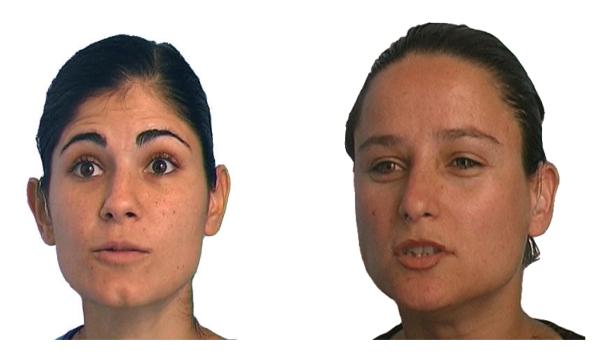
ISL grammatical facial expressions. Raised brows indicate continuation or dependency; squint is a signal to retrieve shared information.
In 12, the two expressions are seen individually. In Figure 11a above, they are simultaneously combined. Raised brows in Figure 11a (made salient by lines in the forehead) conveys continuation between that clause and the following clause, ran away. Squint (made salient by the line under the eyes) conveys the facial intonation of shared information on the relative clause, that I found last week. Crucially, these facial cues are aligned with manual cues of timing and with body posture to delineate the prosodic constituents in this linguistic system. Systematic comparisons with other sign languages have yet to be carried out.
Just as emotional intonation in spoken language can usually be distinguished from linguistic intonation (Ladd 2006), emotional and linguistic facial expression in sign language are also distinguishable (Baker-Shenk 1983; Dachkovsky 2005, 2011), and they interact (de Vos, van der Kooij and Crasborn (2009).
6. The nondominant hand
While most signs are formed with one hand only, many signs are two handed. One hand, generally the preferred hand of the signer, is dominant, in the sense that it is the hand typically used for one-handed signs, and it is the hand that moves in signs in which only one hand moves. The dominant hand is also the hand that survives if one hand is dropped in a two-handed sign (Padden & Perlmutter 1987). Some two-handed signs in Sign Language of the Netherlands (SLN) appear in Figure 13.
Figure 13.
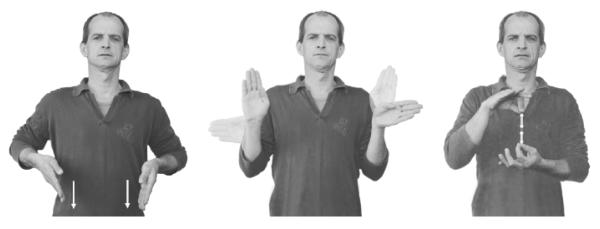
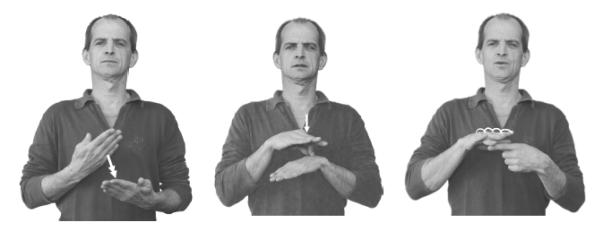
a Symmetrical two-handed signs STAND, WEAKLING, TRAFFIC, in Sign Language of the Netherlands. Reprinted with permission from Onno Crasborn.
b Two-handed signs in which the nondominant hand is a static place of articulation, EVIDENCE, ILL, PHONOLOGY, in SLN. Reprinted with permission from Onno Crasborn.
In lexical signs such as these, the nondominant hand conveys a meaningless phonological element, and as such participates in the phonology. It is the target of a deletion rule called Weak Drop. This rule applies ‘postlexically’ – when words are strung together in sentences, and not part of the lexical morpho-phonology (Padden & Perlmutter 1987; Brentari 1998). As Crasborn (2011) points out, Battison’s two constraints in Table 1 above hold up quite robustly for lexical signs across many different sign languages (Schermer 1990 for SLN; Boyes Braem 1995 for Swiss German Sign Language; Johnston and Schembri 2007 for Australian Sign Language; Eccarius & Brentari 2007 for Hong Kong Sign Language).
In a special part of the grammar of many sign languages known as classifier constructions, each hand functions as a separate morpheme rather than as a meaningless phonological unit (Supalla 1986; Emmorey 2003). For example, in an ASL expression meaning ‘A car ran into a pole,’ one hand can be configured for the VEHICLE classifier, and the other configured to represent a classifier for a LONG-THIN-OBJECT (Supalla 1986). In the expression, the VEHICLE hand approaches and contacts the LONG-THIN-OBJECT hand, as shown in Figure 14. In this system, the constraints on the nondominant hand are more relaxed (Aronoff et al 2003). Even in this hybrid system, however, there are limits on the amount of complexity manifested by the two handshapes (Eccarius and Brentari 2007).
Figure 14.
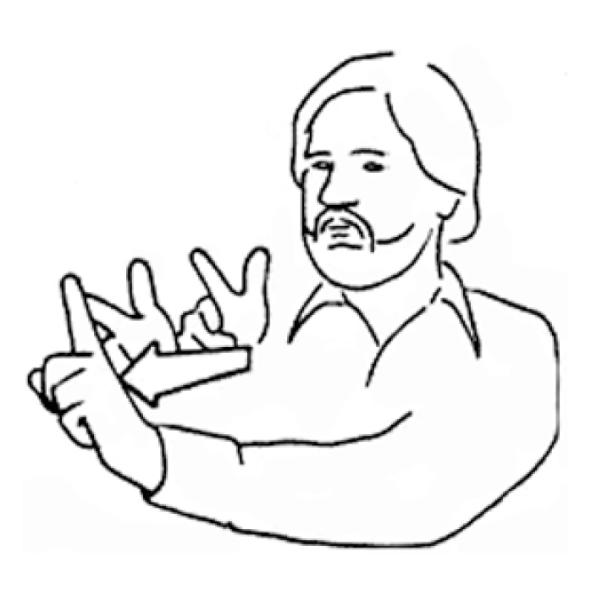
Classifier construction in which each hand encodes a morpheme: VEHICLE, and LONG-THIN-OBJECT. ‘A car runs into a telephone pole.’ Reprinted with permission from Ted Supalla.
In addition to phonological and morphological roles at the level of the lexical sign, the nondominant hand serves prosodic functions as well. In one phenomenon, Nondominant Hand Spread (NHS), this dual articulator spreads beyond the scope of the sign. Triggered by its participation in a two-handed sign, the nondominant hand may appear in the signal before the sign or stay in the signal after the sign – but just as far as the boundary of a prosodic phrase (specifically, a phonological phrase, Nespor & Sandler 1999 for ISL; attested also in SLN, Crasborn 2011). The ISL phrase BAKE CAKE is given as an example in Figure 15, where the nondominant hand is part of the sign for BAKE and remains in the signal during the signing of CAKE by the dominant hand. The phrase is extracted from the sentence, ‘I told him to bake a tasty cake, one for me and one for my sister.’ [I -TELL HIM] P [BAKE CAKE] P [TASTY] P] I [[ONE FOR ME] P [ONE FOR SISTER] P] I.
Figure 15.
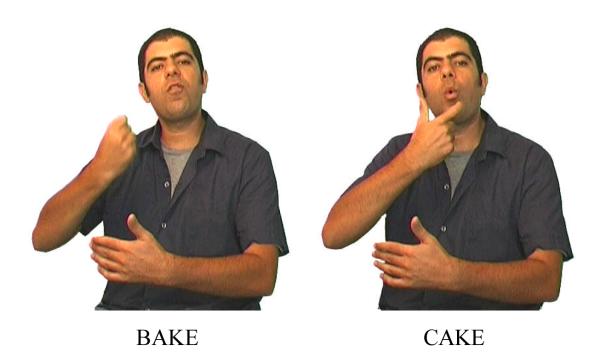
Nondominant hand spread in a phonological phrase. The sign BAKE is specified for the nondominant hand, but the sign CAKE is one-handed. The nondominant hand stays in the signal till the end of the phonological phrase.
At the discourse level, the nondominant hand, configured to represent a sign or a classifier, can remain in the signal throughout an entire stretch of discourse signed by the dominant hand, to background the concept it stands for (Brentari & Goldsmith 1993; Sandler & Lillo-Martin 2006; Liddell 2007; Fenlon 2010). For a taxonomy of roles of the nondominant hand in ASL grammar, see Liddell (2007); and see Crasborn (2011) for a current overview of the phonology of the nondominant hand in sign languages.
Phonology was described in the introduction as the junction where body meets grammar. This union is revealed most dramatically by the nondominant hand, the dual articulator offered by the body and recruited by the grammar to perform a wide variety of roles in a linguistic system -- in the discourse, the prosody, the morphology, and within the phonology proper. The nondominant hand thus provides a kind of scaffolding for the sign stream, supporting and framing different levels of linguistic structure.
7. Similarities across SLs explained by their youth
The central properties of sign language phonology and constraints on its organization have been presented here with reference to several sign languages and illustrated with examples from three sign languages. By and large, the literature suggests that these characteristics indeed hold across sign languages generally, although, as noted above, differences have also been observed. But there is good reason for sign language phonologies to look similar to one another: their youth.
That language age is relevant to the development of phonology can be seen by studying sign languages from their inception. A newly emerging sign language in an insular Bedouin community in Israel’s Negev desert, Al-Sayyid Bedouin Sign Language (ABSL), is a case in point. This language functions effectively as a language and exhibits a certain amount of grammatical structure in syntax, morphology, and prosody (Sandler et al 2005; Meir et al 2010; Padden et al 2010; Sandler et al 2011a,b). But at the sublexical level in ABSL, minimal pairs are all but absent; variation that crosses common phonological boundaries is found in sign production across signers (Israel and Sandler 2010, 2011); and constraints such as those shown in Table 1 appear to be more frequently violated (Sandler et al 2011). Figure 16 shows two variants of the ABSL sign DOG, each signed at a different major place of articulation. The same two places of articulation are contrastive in more established sign languages, as exemplified above by ISL Figures 1c SCOLD and 1d SEND.
Figure 16.
Two variants for the sign DOG in Al Sayyid Bedouin Sign Language, at different places of articulation.
At the same time, this research identifies the kernels of phonological structure, primarily in the manipulation of meaningless units in limited but discrete assimilation phenomena and in indications that younger signers are moving away from iconicity in the direction of formational ease and structural regularity (Sandler et al 2011a).
A different study that aimed to identify early stages of phonological structure elicited two different types of classifier-like constructions from three groups of subjects: gesturers, home signers (deaf people who were raised with no sign language model and developed a gestural system of their own), and deaf signers of established sign languages (Brentari et al 2011). That study shows different kinds of handshape complexity in each type of classifier in the two unrelated established sign languages studied, suggesting that there is a correspondence between these particular morphological categories and phonological characteristics in established sign languages generally. A cline was found indicating a proclivity for this type of organization as gestural communication becomes more systematic: gesture > home sign > sign language.
Evidence from emerging sign systems implies that their older sisters began in a similar way, eventually phonologizing formational tendencies that exist in any language in this modality. Since no known sign language is more than a few hundred years old, it is reasonable to predict that they will all develop more language-specific phonological constraints and processes as they continue to be used through the centuries.
8. Theoretical implications and conclusion
The existence of sign language phonology and its characteristics provide important evidence for linguistic theory, though, interestingly, claims based on such evidence may be contradictory. Berent interprets similarities such as those just noted between spoken and sign language phonology as further evidence for her concept of a specialized ‘phonological mind’ (Berent, to appear). At the other end of the spectrum, Evans and Levinson (2009) interpret the lack of phonological organization in Al-Sayyid Bedouin Sign Language (see section 7) as evidence that the existence of phonology is not a universal property of human language.
The gradual emergence of sign language phonology is consistent with principles of the theory of Evolutionary Phonology (Blevins 2004), which is based on a broad survey and analysis of the phonological histories of spoken languages. The theory proposes that most properties of the synchronic phonology of any language result from the interaction of physical, cognitive, and social forces in its history rather than from properties that are intrinsic to the language faculty. The examples in the previous section are compatible with this view, showing that phonology is not in place as soon as a sign language arises, but rather emerges gradually, developing the kernels of phonological properties through use and transmission.
To the physical, general cognitive, and social forces affecting the formation of phonology we must add linguistic forces – not in the sense of innate phonological properties, but rather in the sense of pressures within the grammar. For example, there is a good deal of evidence that phonological processes that alter the form of words when they are uttered in sentences often have different properties from those that apply when complex words are formed in the lexicon (Kiparsky 1982, 2002; Kaisse and Shaw 1985). Sign languages have been argued to have the same linguistic architecture (Padden and Perlmutter 1987; Sandler 1993b). Such patterns of units and rule systems within the grammar suggest pressures on the formation of phonology that are strictly linguistic in nature. What is meant by ‘strictly linguistic’, however, is no better understood in the sign language domain than it is in that of spoken language (see Anderson (1993) for a thought-provoking discussion of phonology in the two modalities).
The common phonological phenomena that researchers have identified across sign languages may reflect the first stages of phonological organization of languages in the sign modality, where phonetically grounded tendencies become part of the phonological grammar. Differences have emerged, however, and others will no doubt be found. There is much territory left to be charted, as we continue to investigate the ways in which physical, cognitive, social, and linguistic forces mold the phonology of sign languages over the generations.
ACKNOWLEDGMENTS
Research on prosody in ISL was supported by Israel Science Foundation Grant 750/99-1. Research on Al-Sayyid-Bedouin Sign Language is supported by NIH Grant DC6473. Thank you to Iris Berent, Diane Brentari, Itamar Kastner, and an anonymous reviewer for helpful comments on this paper.
References
- Ann Jean. PhD dissertation. University of Arizona; Tucson: 1993. A linguistic investigation of the relationship between physiology and handshape. [Google Scholar]
- Ann Jean. A functional explanation of Taiwan Sign Language handshape frequency. Language and Linguistics. 2005;6:217–246. [Google Scholar]
- Aronoff Mark, Meir Irit, Sandler Wendy. The paradox of sign language morphology. Language. 2005;81:301–344. doi: 10.1353/lan.2005.0043. [DOI] [PMC free article] [PubMed] [Google Scholar]
- Aronoff Mark, Meir Irit, Padden Carol, Sandler Wendy. Classifier constructions and morphology in two sign languages. In: Emmorey Karen., editor. Perspectives on classifier constructions in sign languages. Lawrence Erlbaum Associates; Mahwah, NJ: 2003. pp. 53–85. [Google Scholar]
- Baker-Shenk Charlotte. A microanalysis of the nonmanual components of questions in American Sign Language. University of California Press; Berkley: 1983. [Google Scholar]
- Battison Robbin. Lexical borrowing in American Sign Language. Linstok Press; Silver Spring: 1978. [Google Scholar]
- Benedicto E, Brentari Diane. Where did all the arguments go? Argument-changing properties of classifiers in ASL. Natural Language and Linguistic Theory. 2004;22:743–810. [Google Scholar]
- Berent Iris. The phonological mind. Cambridge University Press; Cambridge: To appear. [Google Scholar]
- Blevins Juliette. The nature of constraints on the nondominant hand in ASL. In: Coulter Geoffrey., editor. Phonetics and phonology. Vol.3. Academic Press; NY: 1993. pp. 43–62. [Google Scholar]
- Blevins Juliette. Evolutionary phonology. Cambridge University Press; Cambridge: 2004. [Google Scholar]
- Boyes-Braem Penny. PhD dissertation. University of California; 1981. Distinctive features of the handshapes of American Sign Language. [Google Scholar]
- Boyes Braem Penny. Einfuhrung in die Gebärdensprache und ihre Erforschung. Signum; Hamburg: 1995. [Google Scholar]
- Brentari Diane. Handshape in sign language phonology. In: van Oostendorp Marc, Ewen Colin J., Hume Elizabeth V., Rice Keren., editors. The Blackwell companion to phonology. Wiley-Blackwell; Hoboken, NJ: 2011a. pp. 195–222. [Google Scholar]
- Brentari Diane, Eccarius Petra. Handshape contrasts in sign language phonology. In: Brentari Diane., editor. Sign languages: A Cambridge language survey. Cambridge University Press; Cambridge, UK: 2010. pp. 284–311. [Google Scholar]
- Brentari Diane, Marie Coppola, Laura Mazzoni, Goldin-Meadow Susan. When does a system become phonological? Handshape production in gesturers, signers, and homesigners. Natural Language and Linguistic Theory. In press. [DOI] [PMC free article] [PubMed]
- Brentari Diane, Goldsmith John A. Secondary licensing and the non-dominant hand. In: Coulter Geoffrey., editor. Phonetics and phonology. Vol.3. Academic Press; NY: 1993. pp. 17–41. [Google Scholar]
- Brentari Diane, Padden Carol. A language with multiple origins: Native and foreign vocabulary in American Sign Language. In: Brentari Diane., editor. Foreign vocabulary in sign language: A cross-linguistic investigation of word formation. Lawrence Erlbaum Associates; Mahwah, NJ: 2001. pp. 87–119. [Google Scholar]
- Brentari Diane. PhD dissertation. University of Chicago; 1990. Theoretical foundations of American Sign Language phonology. [Google Scholar]
- Brentari Diane. A prosodic model of sign language phonology. MIT Press; Cambridge, MA: 1998. [Google Scholar]
- Brentari Diane. Modality differences in phonology and morphophonemics. In: Meier Richard P, Cormier Kearsy, Quinto-Pozos David., editors. Modality and structure in signed and spoken language. Cambridge University Press; Cambridge: 2002. pp. 35–64. [Google Scholar]
- Brentari Diane. Sign language phonology. In: Goldsmith John, Riggle Jason, Yu Alan., editors. Handbook of phonological theory. Wiley-Blackwell; Hoboken, NJ: 2011b. pp. 691–721. [Google Scholar]
- Cecchetto Carlo, Carlo Geraci, Zucchi Sandro. Anothher way to mark syntactic dependencies: the case for right-peripheral specifiers in sign languages. Language. 2009;85:278–320. [Google Scholar]
- Channon Rachel. PhD dissertation. University of Maryland; 2002. Signs are single segments: phonological representations and temporal sequencing in ASL and other sign languages. [Google Scholar]
- Cheek Adrienne. PhD Thesis. University of Texas at Austin; Austin, Texas: 2001. The phonetics and phonology of handshape in American Sign Language. [Google Scholar]
- Clements George N. The geometry of phonological features. Phonology Yearbook. 1985;2:225–252. [Google Scholar]
- Corina David. Reassessing the role of sonority in syllable structure: evidence from a visual-gestural language. In: Ziolkowski Michael, Dobrin Lise, Deaton Karen., editors. Papers from the Chicago Linguistic Society. Chicago Linguistic Society; Chicago: 1990. pp. 33–44. [Google Scholar]
- Corina David. To branch or not to branch: Underspecification in ASL handshape contours. In: Coulter Geoffrey., editor. Current issues in ASL phonology. Academic Press; New York, San Francisco, London: 1993. pp. 63–95. [Google Scholar]
- Coulter Geoffrey. On the nature of ASL as a monosyllabic language. Paper presented at the Annual Meeting of the Linguistic Society of America; San Diego, CA. 1982. [Google Scholar]
- Coulter Geoffrey., editor. Current issues in ASL phonology. Academic Press; New York: 1993. [Google Scholar]
- Crasborn Onno, van der Kooij Els. Relative orientation in sign language phonology. In: Coerts Jane, de Hoop Helen., editors. Linguistics in the Netherlands. John Benjamins; Amsterdam: 1997. pp. 37–48. [Google Scholar]
- Crasborn Onno. The other hand in sign language phonology. In: van Oostendorp Marc, Ewen Colin J., Hume Elizabeth V., Rice Keren., editors. The Blackwell companion to phonology. Wiley-Blackwell; 2011. pp. 223–240. [Google Scholar]
- Crasborn Onno. The phonetic study of signed languages. In: Pfau Roland, Steinbach Markus, Woll Bencie., editors. Sign language: An international handbook. Mouton de Gruyter; Berlin: In press. [Google Scholar]
- Dachkovsky Svetlana. Facial expression as intonation in Israeli Sign Language: the case of conditionals. University of Haifa; MA thesis: 2005. [Google Scholar]
- Dachkovsky Svetlana. Facial expression as intonation in Israeli Sign Language: the case of neutral and counterfactual conditionals. In: Quer Josep., editor. Signs of the time. Leading research in sign language. Signum Press; Hamburg: 2008. pp. 61–82. [Google Scholar]
- Dachkovsky Svetlana. Distinguishing linguistic from non-linguistic intonation in a sign language. University of Haifa, ms; 2011. [Google Scholar]
- Dachkovsky Svetlana, Sandler Wendy. Visual intonation in the prosody of a sign language. Language and Speech. 2009;52:287–314. doi: 10.1177/0023830909103175. [DOI] [PubMed] [Google Scholar]
- Connie De Vos, van der Kooij Else, Crasborn Onno. Mixed signals: Combining linguistic and affective functions of eyebrows in questions in Sign Language of the Netherlands. Language and Speech. 2009;52:315–339. doi: 10.1177/0023830909103177. [DOI] [PubMed] [Google Scholar]
- Eccarius Petra. In: Formational units in sign language. Channon Rachel, van der Hulst Harry., editors. Vol. 3. Ishara Press / Mouton de Gruyter; Nijmegen / Berlin: 2011. pp. 261–284. (Sign Language Typology Series). [Google Scholar]
- Eccarius Petra. MA thesis. Purdue University; 2002. Finding common ground: A comparison of Handshape across multiple sign languages. [Google Scholar]
- Eccarius Petra. PhD. dissertation. Purdue University; West Lafayette, IN: 2008. A constraint-based account of handshape contrast in sign languages. [Google Scholar]
- Eccarius Petra, Brentari Diane. Symmetry and dominance: A cross-linguistic study of signs and classifier constructions. Lingua. 2007;117:1169–1201. [Google Scholar]
- Karen Emmorey., editor. Perspectives on classifier constructions in sign languages. Lawrence Erlbaum Associates; Mahwah, NJ: 2003. [Google Scholar]
- Elisabeth Engberg-Pedersen. Some simultaneous constructions in Danish Sign Language. In: Brennan Mary, Turner Graham., editors. Word-order issues in sign language. ISLA; Durham, England: 1994. pp. 18–22. [Google Scholar]
- Evans Nick, Levinson Steven. The myth of language universals: Language diversity and its importance for cognitive science. Behavioral and Brain Sciences. 2009;32:429–492. doi: 10.1017/S0140525X0999094X. [DOI] [PubMed] [Google Scholar]
- Ewen Colin J. Dependency relations in phonology. In: Goldsmith John A., editor. The handbook of phonological theory. Wiley-Blackwell; 1995. pp. 570–585. [Google Scholar]
- Fenlon Jordan. PhD dissertation. University College London; 2010. Seeing sentence boundaries: the production and perception of visual markers signaling boundaries in sign languages. [Google Scholar]
- Fischer, Gong . Variation in East Asian sign language structures. In: Brentari Diane., editor. Sign Languages: A Cambridge Language Survey. Cambridge University Press; Cambridge: 2010. pp. 499–518. [Google Scholar]
- Fischer Susan, Gong Qunhu. Marked Hand Configurations in Asian Sign Languages. In: Channon Rachel, van Harry der Hulst., editors. Formational units in sign language. Vol. 3. Ishara Press / Mouton de Gruyter; Nijmegen / Berlin: 2011. pp. 19–42. (Sign Language Typology Series). [Google Scholar]
- Flemming E. Auditory representations in phonology. New York: Routledge: 2002. [Google Scholar]
- Goldsmith John. PhD dissertation. MIT Press; 1976. Autosegmental phonology. [Google Scholar]
- Hayes Bruce. In: Against movement. Current issues in ASL phonology. Coulter Geoffrey., editor. Academic Press; San Diego: 1993. pp. 213–226. [Google Scholar]
- Hockett Charles. The origin of speech. Scientific American. 1960;203:89–96. [PubMed] [Google Scholar]
- Hulst Harry van der. Units in the analysis of signs. Phonology. 1993;10:209–41. [Google Scholar]
- Hulst Harry van der. On the other hand. Lingua. 1996;98:121–143. [Google Scholar]
- Israel Assaf, Sandler Wendy. Observing the birth of phonology. In: Smith Andrew D., Schouwstra Marieke, de Boer Bart, Smith Kenny., editors. The evolution of language: Proceedings of the 8th international conference; Singapore: World Scientific; 2010. pp. 423–425. [Google Scholar]
- Israel Assaf, Sandler Wendy. Phonological category resolution: A study of handshapes in younger and older sign languages. In: Channon Rachel, van der Hulst Harry, Language Sign., editors. Formational units in sign language. Vol. 3. Ishara Press / Mouton de Gruyter; Nijmegen / Berlin: 2011. pp. 177–202. (Typology Series). [Google Scholar]
- Johnston Trevor, Schembri Adam. Australian sign language: An introduction to sign language linguistics. Cambridge University Press; Cambridge: 2007. [Google Scholar]
- Klima Edward S., Bellugi Ursula. The signs of language. Harvard University Press; Cambridge, MA: 1979. [Google Scholar]
- Kooij Else van der. PhD dissertation. Leiden University; 2002. Phonological categories in Sign Language of the Netherlands: The role of phonetic implementation and iconicity. [Google Scholar]
- Ladd Robert. Intonational Phonology. Cambridge University Press; Cambridge: 1996. [Google Scholar]
- Liddell Scott K. Think and Believe: Sequentiality in American Sign Language. Language. 1984;60:372–399. [Google Scholar]
- Liddell Scott K. Grammar, Gestures and Meaning in American Sign Language. Cambridge University Press; Cambridge: 2003. [Google Scholar]
- Liddell Scott K., Johnson Robert E. American Sign Language compound formation processes, lexicalization, phonological remnants. Natural Language and Linguistic Theory. 1986;8:445–513. [Google Scholar]
- Liddell Scott K., Johnson Robert E. American Sign Language: The phonological base. Sign Language Studies. 1989;64:195–277. [Google Scholar]
- Lillo-Martin Diane, Klima Edward S. Pointing out differences: ASL pronouns in syntactic theory. In: Fischer Susan D., Siple Patricia., editors. Theoretical issues in sign language research. University of Chicago Press; Chicago: 1990. pp. 176–198. [Google Scholar]
- Mak Joe, Tang Gladys. Movement types and feature organization in Hong Kong Sign Language. In: Channon Rachel, van der Hulst Harry., editors. Formational units in sign language. Vol. 3. Ishara Press / Mouton de Gruyter; Nijmegen / Berlin: 2011. pp. 315–338. (Sign Language Typology Series). [Google Scholar]
- Mandel Mark. PhD dissertation. University of California; Berkeley: 1981. Phonotactics and morphophonology in ASL. [Google Scholar]
- Martinet André. Éléments de linguistique générale. Armand Colin; Paris: 1960. [Google Scholar]
- Mauk Claude E., Björn Lindblom, Meier Richard P. Undershoot of ASL locations in fast signing. In: Quer Josep, Seedorf, editors. Signs of the time: Selected papers from TISLR 2004. Signum Press; Germany: 2008. [Google Scholar]
- Mauk Claude. PhD dissertation. University of Texas; Austin: 2003. Undershoot in two modalities: Evidence from fast speech and fast signing. [Google Scholar]
- McCarthy John. A prosodic theory of nonconcatenative morphology. Linguistic Inquiry. 1981;17:207–263. [Google Scholar]
- McCarthy John. What is Optimality Theory? Language and Linguistics Compass. 2007;1:260–291. [Google Scholar]
- Meier Richard. Why different, why the same? Explaining effects and non-effects of modality upon linguistic structure in sign and speech. In: Meier Richard P., Cormier Kearsy, Quinto-Pozos David., editors. Modality and structure in signed and spoken languages. Cambridge University Press; Cambridge: 2002. pp. 1–26. [Google Scholar]
- Meir Irit, Sandler Wendy. A language in space: The story of Israeli Sign Language. Lawrence Erlbaum Associates/Taylor Francis; New York: 2008. [Google Scholar]
- Meir Irit, Aronoff Mark, Sandler Wendy, Padden Carol. Sign languages and compounding. In: Scalise Sergio, Vogel Irene., editors. Compounding. John Benjamins; Amsterdam: 2010. pp. 301–322. [Google Scholar]
- Nespor Marina, Sandler Wendy. Prosody in Israeli Sign Language. Language and Speech. 1999;42:143–176. [Google Scholar]
- Newkirk Don. On the temporal segmentation of movement in American Sign Language. Salk Institute of Biological Studies, ms; La Jolla, California: 1981. [Google Scholar]
- Padden Carol, Perlmutter David M. American Sign Language and the architecture of phonological theory. Natural Language and Linguistic Theory. 1987;5:335–375. [Google Scholar]
- Padden Carol, Meir Irit, Sandler Wendy, Aronoff Mark. Against all expectations: Encoding subjects and objects in a new language. In: Gerdts Donna B., Moore John C., Polinsky Maria., editors. Hypothesis A/Hypothesis B: Linguistic explorations in honor of David M. Perlmutter. MIT Press; Cambridge, MA: 2010. [Google Scholar]
- Padden Carol. Interaction of Morphology and Syntax in American Sign Language: Outstanding Dissertations in Linguistics. Garland; New York: 1988. [1983] [Google Scholar]
- Perlmutter David. Feature geometry in a language with two active articulators. Paper presented at Conference on Segmental Structure; Santa Cruz. 1991. [Google Scholar]
- Perlmutter David. Sonority and syllable structure in American Sign Language. Linguistic Inquiry. 1992;23:407–442. [Google Scholar]
- Prince Alan, Smolensky Paul. Optimality theory: constraint interaction in generative grammar. New Brunswick and Boulder, ms; 1993. [Google Scholar]
- Reilly Judy S., McIntire Marina, Bellugi Ursula. The acquisition of conditionals in American Sign Language: Grammaticized facial expressions. Applied Psycholinguistics. 1990;11:369–392. [Google Scholar]
- Sagey Elizabeth. MIT thesis. Cambridge, MA: 1986. The representation of features and relations in non-linear phonology. [Google Scholar]
- Sandler Wendy. The spreading hand autosegment of American Sign Language. Sign Language Studies. 1986;50:1–28. [Google Scholar]
- Sandler Wendy. Assimilation and feature hierarchy in ASL. In: Bosch Anne, Need Barbara, Schiller Eric., editors. Chicago Linguistics Society parasession on autosegmental phonology. Chicago Linguistic Society; Chicago: 1987. pp. 266–278. [Google Scholar]
- Sandler Wendy. Phonological representation of the sign: Linearity and nonlinearity in American Sign Language. Foris Publications; Dordrecht, Holland: 1989. [Google Scholar]
- Sandler Wendy. Temporal aspects and ASL phonology. In: Fischer Susan, Siple Patricia., editors. Theoretical issues in sign language research. Vol 1: Linguistics. University of Chicago Press; Chicago: 1990. pp. 7–36. [Google Scholar]
- Sandler Wendy. A sonority cycle in American Sign Language. Phonology. 1993a;10:209–241. [Google Scholar]
- Sandler Wendy. Linearization of phonological tiers in American Sign Language. In: Coulter Geoffrey., editor. Phonetics and Phonology. Vol. 3: Current Issues in ASL Phonology. Academic Press; San Diego, CA: 1993b. pp. 103–129. [Google Scholar]
- Sandler Wendy. Hand in hand: The roles of the nondominant hand in sign language phonology. The Linguistic Review. 1993c;10:337–390. [Google Scholar]
- Sandler Wendy. Representing handshapes. In: Edmondson William, Wilbur Ronnie B., editors. International review of sign linguistics. Lawrence Erlbaum Associates; Mahwah, NJ: 1996. pp. 115–158. [Google Scholar]
- Sandler Wendy. Cliticization and prosodic words in a sign language. In: Hall Tracy Alan, Kleinhenz Ursula., editors. Studies on the Phonological Word. John Benjamins; Amsterdam: 1999a. pp. 223–254. [Google Scholar]
- Sandler Wendy. The medium and the message: Prosodic interpretation of linguistic content in sign language. Sign Language and Linguistics. 1999b;2:187–216. [Google Scholar]
- Sandler Wendy. Phonology, phonetics and the nondominant hand. In: Goldstein Louis, Whalen Douglas, Best Catherine., editors. Papers in laboratory phonology: Varieties of phonological competence. Mouton de Gruyter; Berlin: 2005. pp. 185–212. [Google Scholar]
- Sandler Wendy. Phonology, phonetics, and the nondominant hand. In: Goldstein Louis, Whalen DH, Best Catherine., editors. Papers in Laboratory Phonology: Varieties of Phonological Competence. Mouton-de Gruyter; Berlin: 2006. pp. 185–212. [Google Scholar]
- Sandler Wendy. The syllable in sign language: considering the other natural language modality. In: Davis Barbara, Zajdo Kristine., editors. The Syllable in Speech Production. Taylor & Francis; New York: 2008. pp. 379–408. [Google Scholar]
- Sandler Wendy. The phonology of movement in sign language. In: van Oostendorp Marc, Ewen Colin J., Hume Elizabeth V., Rice Keren., editors. The Blackwell companion to phonology. Wiley-Blackwell; 2011a. pp. 577–603. [Google Scholar]
- Sandler Wendy. Prosody and syntax in sign language. Transactions of the Philological Society. 2011b;108:298–328. doi: 10.1111/j.1467-968X.2010.01242.x. [DOI] [PMC free article] [PubMed] [Google Scholar]
- Sandler Wendy. To appear. The visual prosody of sign language. In: Pfau Roland, Steinbach Markus, Woll Bencie., editors. Sign language: An international handbook. Mouton de Gruyter; Berlin: [Google Scholar]
- Sandler Wendy, Lillo-Martin Diane. Sign language and linguistic universals. Cambridge University Press; Cambridge, UK: 2006. [Google Scholar]
- Sandler Wendy, Aronoff Mark, Meir Irit, Padden Carol. The gradual emergence of phonological form in a new language. Natural Language and Linguistic Theory. 2011;29:503–543. doi: 10.1007/s11049-011-9128-2. [DOI] [PMC free article] [PubMed] [Google Scholar]
- Sandler Wendy, Meir Irit, Padden Carol, Aronoff Mark. The emergence of grammar: Systematic study in a new language. Proceedings of the National Academy of Sciences. 2005;102:2661–2665. doi: 10.1073/pnas.0405448102. [DOI] [PMC free article] [PubMed] [Google Scholar]
- Sandler Wendy, Meir Irit, Dachkovsky Svetlana, Aronoff Mark, Padden Carol. Prosody and linguistic complexity in an emerging language. In: Smith Andrew D. M., Smith Kenny, Ferrer i Cancho Ramon., editors. The evolution of language. World Scientific; Singapore: 2008. pp. 489–490. [Google Scholar]
- Sandler Wendy, Meir Irit, Dachkovsky Svetlana, Padden Carol, Aronoff Mark. The emergence of complexity in prosody and syntax. Lingua. 2011;121:13, 2014–2033. doi: 10.1016/j.lingua.2011.05.007. [DOI] [PMC free article] [PubMed] [Google Scholar]
- Schermer Trude. PhD dissertation. University of Amsterdam; 1990. In search of a language: Influences from spoken Dutch on Sign Language of the Netherlands. [Google Scholar]
- Stack Kelly. MA thesis. UCLA; 1988. Tiers and syllable structure in American Sign Language: evidence from phonotactics. [Google Scholar]
- Stokoe William C. Studies in Linguistics, Occasional papers 8. University of Buffalo; Buffalo: 1960. Sign language structure: An outline of the visual communication systems of the American deaf. [DOI] [PubMed] [Google Scholar]
- Supalla Ted, Newport Elissa. How many seats in a chair? The derivation of nouns and verbs in American Sign Language. In: Siple Patricia., editor. Understanding language through sign language research. Academic Press; New York: 1978. pp. 91–132. [Google Scholar]
- Supalla Ted. The classifier system in American Sign Language. In: Craig Collette., editor. Noun classification and categorization. John Benjamins; Amsterdam: 1986. pp. 118–214. [Google Scholar]
- Tang G. Hong Kong Sign Language: A trilingual dictionary with linguistic descriptions. the Chinese University Press; Hong Kong: 2007. [Google Scholar]
- Whittemore Greg. PhD dissertation. University of Texas; Austin: 1987. The production of ASL signs. [Google Scholar]
- Wilbur Ronnie. Sign syllables. In: van Oostendorp Marc, Ewen Colin J., Hume Elizabeth V., Rice Keren., editors. The Blackwell companion to phonology. Wiley-Blackwell; 2011. pp. 1309–1334. [Google Scholar]
- Wilbur Ronnie. Intonation and focus in American Sign Language. In: No Yongkyoon, Libucha Mark., editors. ESCOL ’90: Proceedings of the Seventh Eastern States Conference on Linguistics. Ohio State University Press; Columbus, OH: 1991. pp. 320–331. [Google Scholar]
- Wilbur Ronnie. Syllables and segments: hold the movements and move the holds! In: Coulter Geoffrey., editor. Current issues in ASL phonology. Academic Press; New York, San Francisco, London: 1993. [Google Scholar]
- Wilbur Ronnie. Phonological and prosodic layering of non-manuals in American Sign Language. In: Emmorey Karen, Lane Harlane., editors. The signs of language revisited. Lawrence Erlbaum Associates; Mahwah, NJ: 2000. pp. 215–247. [Google Scholar]
- Wilbur Ronnie, Klima Ed, Bellugi Ursula. Roots: on the search for the origins of signs in ASL. In: Richardson John, Marks Mitchell, Chukerman Amy., editors. Proceedings of CLS 19: The Chicago Society Parasession on the Interplay of Phonology, Morphology, and Syntax. Chicago Linguistic Society; Chicago: 1983. pp. 314–336. [Google Scholar]




